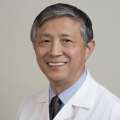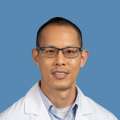When , created the at UCLA Health in 1993, he wasn’t just interested in blending the strengths of Western medicine with Traditional Chinese Medicine.
He wanted to change the whole health care paradigm.
Conventional Western medicine is built around specialists with expertise in the body’s distinct parts. If something’s wrong with your heart, you see a cardiologist. If you break a bone, you go to an orthopedist. Skin issues? Visit a dermatologist. Each condition is addressed individually.
It’s like having “too many subcontractors without a clear understanding of the architect’s design,” Dr. Hui says.
Traditional Chinese Medicine (TCM), on the other hand, takes a holistic view, approaching any seemingly disparate disturbance as a reflection of disruption within the system.
Blending the medical expertise of the West with the comprehensive approach of TCM is a “new model” for health care, Dr. Hui says, one focused on preventive care and whole-system healing.
“The paradigm shift is in understanding how things are interconnected,” Dr. Hui says. “This is not just a medical discipline that I created. It’s more of a new way of thinking.”
Origin of a dream
Born in Hong Kong, Dr. Hui came to UCLA as an undergraduate chemistry major interested in finding new drugs based on herbs. While he was in medical school at UCLA in 1972, a New York Times reporter covering Richard Nixon’s historic visit to China wrote about his own experience receiving acupuncture for abdominal pain.
A lightbulb went on in Dr. Hui’s mind.
Dr. Hui had grown up receiving both Western and Eastern medicine – conventional medical treatment for a burn, for example, and an herbal patch or massage for neck pain. He learned that China had been training Western physicians in TCM practices since the 1950s and imagined blending these modalities at UCLA Health to offer more comprehensive care for patients.
“This was a young medical student’s dream that basically shaped my whole career at UCLA,” he says.
Dr. Hui completed his residency in internal medicine, “because internal medicine is the broadest look at the pathophysiology of the whole person,” and went on to a fellowship in pharmacology. It would take another 15 years for him to start bringing his dream to life.
Growth and expansion
With support from then-chief of the department of medicine, , and funds from donors, Dr. Hui established the Center for East-West Medicine. What began as a one-man operation has since grown to 20 physicians and four stand-alone clinics, plus inpatient services at UCLA Santa Monica Medical Center.
Patients are referred to East-West Medicine by their primary care provider. Its clinics – in Torrance, Westlake Village, Santa Monica and Westwood – treat a wide variety of conditions, including muscle pain, neuropathy, arthritis, asthma, allergies, irritable bowel syndrome, women’s health issues such as painful periods and menopause symptoms, stress, anxiety, depression, insomnia and migraines.
“Pain may bring you here, but we help you solve many problems,” Dr. Hui says.
Treatment may include acupuncture, bodywork such as cupping or massage, trigger-point injections, dietary recommendations and lifestyle practices. At each visit, patients see a physician trained in conventional medicine and TCM who monitors their overall well-being, not just the condition being treated.
Speaking these two languages of healing offers “two different lenses with which to view and solve problems,” says , son of East-West’s founder. Also a graduate of UCLA and the David Geffen School of Medicine, the younger Dr. Hui is the director of East-West Primary Care.
A family affair
Dr. Ed Hui says he hadn’t intended to follow in his dad’s professional footsteps. But as he realized a proficiency for science as an undergrad and decided to pursue medical school, he saw how his father’s integrative approach made sense for today’s health care needs.

In the early days of Dr. Ed Hui’s medical training, “there was increasing recognition from conventional biomedicine that the model wasn’t so great for the aging population and the increasing burden of chronic diseases,” he says.
The fee-for-service approach of modern medicine can’t keep up with the needs of our aging society, Dr. Ka-Kit Hui says, noting how many middle-class families are “one step away” from medical bankruptcy.
The evidence-based East-West Medicine approach focuses on “self-care and health cultivation throughout the life span,” Dr. Ed Hui says, which can help prevent chronic diseases and the high cost of managing them.
“It’s not just the acupuncture points or the herbs,” Dr. Ka-Kit Hui says, “but really the construct of looking at the importance of balance, the importance of flow and the importance of spirit.”
Both modalities are important, he adds. The current medical model saves lives, he says, and can restore the body when its unable to heal itself.
Best of both worlds
The Center for East-West Medicine aims to bridge these two medical pathways, “recognizing that they can help each other,” Dr. Ed Hui says.
The whole-person, preventive-care approach of TCM can lower health care costs, he says, as it promotes lifestyle practices that can reduce the need for prescription drugs and expensive treatments. A found that an inpatient consultation with an East-West Medicine practitioner reduced patients’ hospital readmissions and length of stay.
While there are other integrative medicine programs across the nation, UCLA Health’s Center for East-West Medicine is unique in its focus on TCM and integration with the broader health system, Dr. Ed Hui says.
Future of health care
The center continues to educate physicians, nurses and other health care providers, as well as , on its holistic view of wellness and the role lifestyle practices – diet, exercise, stress management and sleep – play in cultivating health. Dr. Ka-Kit Hui dreams of expanding this training even further.
“Every educated person should know about this model,” he says.
The Center for East-West Medicine has also partnered with community organizations to bring its care to underserved populations. An adolescent program is also being developed, Dr. Ed Hui says, to teach teens the self-care practices that will keep them healthy and ward of chronic diseases throughout their lives.
Now 75, Dr. Ka-Kit Hui still has big dreams for the center’s integrative, preventive approach.
“If we optimize the whole-person health idea and make it culturally appropriate for the 10 million lives in L.A., in the next 20, 30 years, UCLA will be the focal point for health care,” he says. “We’ll make Southern California the focal point for demonstrating a new health model that addresses the health care crisis, making it safer, more affordable and more accessible.”





